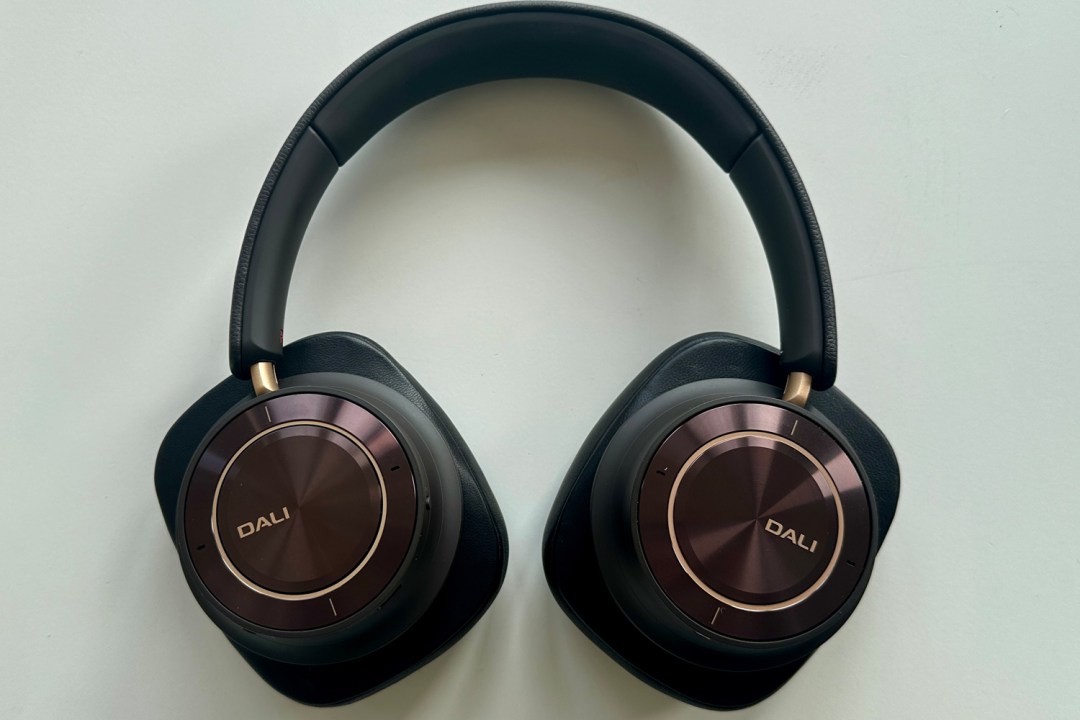Dali IO-12 review: new levels of opulence
So long, vegetarians - it was nice while it lasted.

Introduction
Not for the first time, I blame Apple. It took the AirPods Max to legitimise the idea of properly premium wireless headphones – or, at least, wireless headphones at a properly premium price – and now the bandwagon is being jumped on left, right and centre. From Focal to Mark Levinson, everyone wants a piece of the action – you know a market is on an upwards spiral when range-topping headphones by Bowers & Wilkins look like a bit of a bargain.
And now here’s Dali, ready – with a straight face – to part you from a grand (!) for its IO-12 over-ears. Look at what you’ve done, Apple. Are you happy? Are you happy now?
How we test headphones
Every pair of earphones and headphones reviewed on Stuff is used for a minimum of a week’s worth of daily listening. We use a playlist of test tracks made up of multiple genres to assess sound, and use our years of experience to compare to other models. Manufacturers have no visibility on reviews before they appear online, and we never accept payment to feature products.
Find out more about how we test and rate products.
Design and build: steak cooked rare, please


The Dali IO-12 are quite big headphones, especially where the earcups and earpads are concerned. They also make quite liberal use of leather across the outside of the headband and on both the front and rear of the earpads. It’s tactile and luxurious, sure – but it doesn’t have what you might call ‘universal appeal’.
The IO-12 are unlikely to appeal to the smaller-headed among us, either, given that the nicely padded, square earpads are among the biggest in all of headphone-land. If they fit, though, you’ll find yourself inside some comfortable and exquisitely constructed headphones.
The concealed headband adjust mechanism moves with nicely damped precision, the earpads are carefully shaped to offer the best seal and minimise sound leakage, and the standard of finish is basically impeccable. Which is exactly as it should be, given the asking price…
Features: soft magnetic compound for the win


The Dali IO-12 have multi-point Bluetooth connectivity, and are compatible with SBC, AAC and aptX Adaptive codecs. They can also be wired to a source player, either via the 3.5mm socket on the left earcup or the USB-C input on the right – appropriate cables are in the big, luxurious travel-case into which the headphones fit when they’re folded flat. Using the USB-C input means the headphones’ integrated DAC can deal natively with digital audio files of up to 24bit/96kHz resolution – authentically hi-res, in other words.
The USB-C is also used for charging the battery, of course. Dali is claiming an all-in life from a single charge of 35 hours – which seems eminently achievable to me, as long as you keep active noise-cancellation switched off and don’t cane the volume all the time.
No matter how you get your audio information on board, though, ultimately it’s dealt with by a couple of 50mm full-range dynamic drivers. Dali isn’t quoting a frequency response for the IO-12, but what it is pleased to discuss is the drivers’ ‘Soft Magnetic Compound’ system. Until now, this technology – which intends to eliminate unwanted resistance in the voice-coil and minimise harmonic distortion as a result – has only shown up in the company’s uber-pricey loudspeaker ranges. But if it’s good enough for a pair of £70K Dali Kore loudspeakers, it’s good enough for some expensive headphones, right?
The use of SMC technology is what has led to Dali claiming, with uncharacteristic boldness, that the IO-12 have “electrostatic levels of midrange clarity” and are, in effect, “hi-fi speakers for your head”.
Interface: ‘appily app-free
“Simple, app-free operation” is, according to Dali, what’s available here. Anyone with the slightest intention of dropping a grand on a pair of wireless headphones, though, might think a control app is the least they can expect… The IO-12 interface is properly implemented and effective, it’s true. But with no companion app, control is not as granular as it is with some competing designs.
Take EQ setting and active noise-cancellation, for example. There’s a button for each on the outer edge of the right earcup, and each one responds to presses very speedily indeed. But EQ adjustment is simply a choice between ‘hi-fi’ and ‘bass’ presets, while ANC options extend to ‘on’, ‘off’ or ‘transparency’. Many less expensive headphones are accompanied by apps that offer far more adjustment than that.
The edge of the right earcup features a button for power and pairing. Its outer surface has individual volume controls, as well as a big push/push button covering playback and track skipping.
Both earcups feature a selection of feedback and feed-forward mics, which take care of telephony and active noise-cancellation. They’re also used when controlling the IO-12 using your source player’s native voice-assistant.
Performance: sound as a pound


There’s a fairly definite sonic signature from which the Dali IO-12 don’t really deviate no matter the sort of music, or the standard of the digital file, you listen too. But – and this is hardly a spoiler – these headphones sound their best when given the best stuff to work with. Which means, in this instance, making a wired connection via USB to an Apple MacBook Pro running Colibri software and firing up a 24bit/96kHz FLAC file of Bad Guy by Billie Eilish.
Heard this way, the Dali are an extraordinarily detailed, energetic and articulate listen. They dig deep at the bottom of the frequency range, serving up well-controlled and straight-edged punch that keeps the tempo rolling and the rhythm convincing. At the opposite end they manage to have real crunch and bite without ever letting the treble even threaten to get out of hand. And in between, they retain and reveal so much detail about the singer’s technique and attitude that it’s almost like eavesdropping – the midrange is clean and eloquent, and in tonal terms is utterly convincing. As far as straightforward powers of communication are concerned, the IO-12 are up with the best around.
They have impressive dynamic reach too, able to create some light and shade even in a recording like this one that doesn’t really alter the pitch of its intensity. And when it comes to soundstaging, the Dali demonstrate great poise – the stage they create is big and well-defined, the spaces on it are just as prominent as the sounds, and despite the impressive levels of separation, the overall presentation is unified and of a piece.
They’re an assertive listen, too – maybe not the most out-and-out exciting or upfront pair of headphones you ever heard, but certainly more lively than the rather self-conscious ‘realism’ that many high-end alternatives seem to think is appropriate. The IO-12 strike a really nice balance between ‘analysis’ and ‘entertainment’.
To be honest there’s not a lot of difference between the two available EQ presets. The Hi-Fi preset is a slightly better-balanced presentation that the latter, for sure, but if you’re expecting that the effect of engaging Bass will be a major ramping-up of the low frequencies you’re going to be disappointed. The Dali are a much more refined product than that.
Switching to a 320kbps file of Two Weeks by FKA Twigs delivered wirelessly via Spotify inevitably means accepting across-the-board reductions in detail, definition and straightforward fidelity. But what’s interesting is just how relatively mild these drop-offs are, and how enjoyable and listenable the IO-12 remain. Some expensive headphones turn their noses up at such poverty-spec content, but the Dali just try to make the best of it.
It’s a slightly different, and slightly less stirring, story where the active noise-cancellation that’s available here is concerned. The fact that the IO-12 don’t alter the characteristics of their sound when ANC is switched on is a good thing; the fact that the IO-12 don’t do all that comprehensive a job on external sounds when ANC is switched on isn’t. The reduction in ambient noise is welcome, sure – but you don’t have to look very hard (or spend anything like as much money) to find a pair of wireless noise-cancellers that do a more thorough job when it comes to ‘noise-cancelling’.
Dali IO-12 verdict

Is it stating the bleeding obvious to say you shouldn’t rush into spending £999 on a pair of headphones? The Dali IO-12 have plenty to recommend them, of course – given the right tools to work with, they’re capable of really excellent performance.
But I can’t pretend they’re perfect, especially where noise-cancellation is concerned – and if you’ve got a smaller-than-average head, they’re a non-starter.
Stuff Says…
Big headphones + big performance = big price
Pros
Entertaining, expansive sound
Impressively built and finished from tactile materials
Great suite of responsive physical controls
Cons
So-so noise-cancellation
Going without a control app is not a virtue
Very large price
Dali IO-12 technical specifications
| Drivers | 50mm dynamic w/ SMC magnets |
| Active Noise Cancellation | Yes |
| Connectivity | USB-C, 3.5mm, Bluetooth |
| Bluetooth version | Bluetooth 5.2 |
| Codecs supported | AAC, aptX, aptX HD, aptX Adaptive |
| Battery life | Up to 35 hours |



